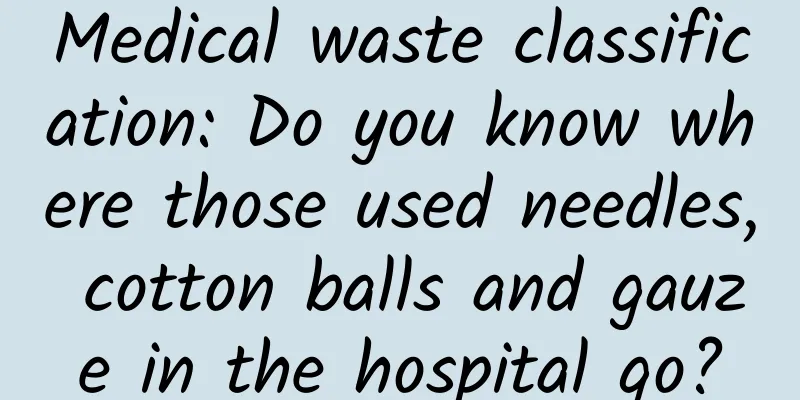Medical waste classification: Do you know where those used needles, cotton balls and gauze in the hospital go?

|
Works by the Science Popularization Group of the Anesthesiology Branch of the Beijing Medical Association What is medical waste? Medical waste, also known as medical waste, refers to contaminated waste produced by hospitals that has come into contact with patients' blood, flesh, etc. Such as: used cotton balls, gauze, adhesive tape, waste water, disposable medical instruments, post-operative waste, expired medicines, etc. Medical waste has characteristics such as space pollution , acute infection and latent pollution . Common waste classification in hospitals 1. Medical waste (yellow trash can): used to place medical waste that has come into contact with patients. 2. Domestic waste (black trash can) : used to place garbage that has not come into contact with patients. The hazards of medical waste Medical waste stained with blood, body fluids and secretions may carry a large number of bacteria and viruses. If medical staff are scratched by used needles, scalpels, etc., they are likely to be infected with diseases. If these medical wastes are processed into tableware, cups, toys, etc. and flow into society, they will cause greater harm and even cause the spread of infectious diseases. Classification of medical waste 1. Damaging waste: The management requirements for discarded medical sharps and discarded metal sharps that can stab or cut the human body are as follows. (1) Injurious waste should be placed in a sharps container; (2) The sharps box is valid for 48 hours; (3) The sharps box must not be filled to the brim. It needs to be replaced when it is 3/4 full. 2. Chemical waste : Toxic, corrosive, flammable and explosive waste chemicals, such as waste chemical reagents after chemical imaging and medical experiments. How to deal with a broken mercury thermometer (1) If a thermometer is accidentally broken indoors, the patient should leave the room immediately, open the windows, keep the room ventilated, and avoid excessive inhalation of mercury exposed to the air. (2) Clean up the spilled mercury promptly and take protective measures. It is recommended to use rubber gloves when handling mercury. Do not handle it with bare hands to avoid direct contact with mercury. Then, you can use cotton swabs, gauze, adhesive tape, etc. with good adsorption properties to handle the mercury on the ground. Then, seal the items that have come into contact with mercury in a bag, mark them clearly, and then throw them into the medical waste bin to prevent others from coming into contact with them. (3) After treating the mercury on the ground, pour iodine tincture on the ground where the mercury is exposed. After the iodine tincture evaporates, the iodine element and mercury element in the air combine to form non-toxic mercuric iodide. Then use soapy water to mop the floor repeatedly. 3. Pharmaceutical waste: Discarded medicines that are expired, obsolete, deteriorated or contaminated. 4. Infectious waste: Medical waste that carries pathogenic microorganisms and has the potential to cause the spread of infectious diseases. 5. Pathological waste : Human waste generated during the diagnosis and treatment process and animal carcasses in medical laboratories, etc. Waste human tissue generated during surgery and other medical treatments. Tissues and corpses of medical experimental animals. Placentas of pregnant women with infectious diseases, suspected infectious diseases, or sudden infectious diseases of unknown causes, as well as stillborn fetuses with a gestational age of less than 16 weeks or a fetal weight of less than 500 g. In hospitals, placentas are centrally processed. Hospitals process placentas by incinerating them as medical waste and medical garbage. Benefits of medical waste classification 1. Benefits to society : reduce land infringement, increase economic value, reduce environmental pollution, and effectively utilize resources. 2. Benefits to medical institutions : Standardized management of medical waste is not only an important indicator of the overall level of a medical institution, but also an effective measure to improve the environment of medical institutions. It is also an important means and guarantee to prevent cross-infection within medical institutions, prevent the spread of diseases, protect the environment, ensure human health, and improve the quality of medical care. 3. Benefits to individuals : Strengthening the standardized management of medical waste is a means to effectively prevent occupational exposure caused by medical waste, and is of great significance to controlling the spread of infectious diseases and environmental pollution. Reasonable treatment and classification of medical waste can not only prevent the spread of infectious diseases, but also effectively prevent its pollution to the surrounding environment, so that patients and medical staff can have a safe and comfortable environment, which is more conducive to the rehabilitation of patients. With the advancement of science and technology and the rapid development of medical research, related drugs and medical equipment will also be updated accordingly. Therefore, it is particularly important to do a good job in the continuous and effective classification management of medical waste and reduce its potential harm to society. Only in this way can medical waste be handled in a standardized and effective manner to reduce its harm to society and the environment. |
<<: Food Safety | Will eating too much sweets cause diabetes? Listen to what the doctor says
Recommend
“Olive oil is the best oil” “Olive oil is a waste of money”? The answer is…
gossip “Olive oil is the best cooking oil” / “Buy...
What are the side effects of purslane?
Purslane has high medicinal value, but when using...
How many days does it take for a natural abortion to end?
A miscarriage is a miscarriage that occurs withou...
So distressing! This thing is too big for a woman
How to improve enlarged pores has always troubled...
A 63-year-old woman had severe coughing at night. The puncture under CT guidance revealed the true shape of the nodule.
Aunt Mo, 63 years old this year, started coughing...
108 days of pregnancy
During the ten months of pregnancy, for pregnant ...
What are the symptoms of no fetal heartbeat or fetal bud?
The fetal heartbeat refers to the gradual formati...
What size bra should I wear if my bust is 102
Upper bust: The bust measurement passing through ...
Can I eat bitter melon when I am pregnant?
Bitter melon is an ingredient that clears away he...
What are the items in a gynecological full body examination?
For the health of women, regular physical examina...
How many days after the menstrual period is delayed can the pregnancy test be detected
After pregnancy, menstruation stops. This is the ...
What should a girl do if she has menstrual pain?
If a woman has abdominal pain during her menstrua...
Breastfeeding health education
Breast milk is an essential and ideal food for in...
Pregnant women's diet for 1 to 3 months
Pregnant women generally experience a significant...
Precautions and taboos after abortion
Sometimes, unexpected pregnancy due to various re...









